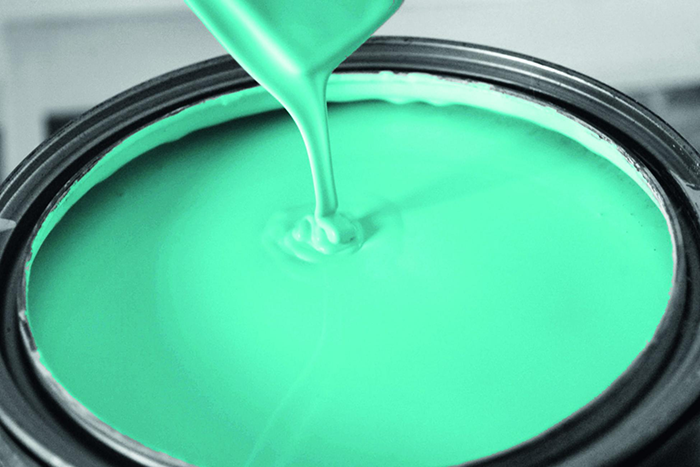The increasing adoption of water-borne coatings in some market segments will be supported by technological advances. By Sarah Silva, contributing editor.

How is the situation at the water-borne coatings market?
Market predictions are consistently positive as might be expected for a sector bolstered by its environmental compatibility. But eco credentials aren’t everything, with cost and ease of application still important considerations.
Research companies agree on steady growth for the global water-borne coatings market. Vantage Market Research reports a value of EUR 90.6 billion for the global market in 2021 and project it will reach a value of EUR 110 billion by 2028, at a CAGR of 3.3 % over the forecast period.
Markets and Markets offer a similar valuation of the water-borne sector in 2021, at EUR 91.5 billion, with a more optimistic CAGR of 3.8 % from 2022 to 2027 to reach EUR 114.7 billion. The company expect the market to reach EUR 129.8 billion by 2030 with the CAGR rising to 4.2 % from 2028 to 2030.
IRL’s data supports this view, with an overall CAGR of 4 % for the water-borne market, this time for the period 2021 to 2026. Rates for the individual segments are given below and offer greater insights.
Scope for greater market share
Architectural coatings dominate the total global sales and volume accounting for over 80 % of the market share according to IRL, who reported a volume of 27.5 million tonnes for this product category in 2021. This is expected to reach almost 33.2 million tonnes by 2026, steadily increasing at a CAGR of 3.8 %. This growth is primarily due to the increased demand as a result of construction activities rather than a substantial switch from other coating types given that this is an application where water-borne coatings already have a strong foothold.
Automotive represents up the second-largest segment with compound annual growth of 3.6 %. This is supported to a large extent by the expansion of car production in Asia, specifically China and India, in response to consumer demand.
Interesting applications with scope for water-borne coatings to capture a greater share in the next few years include industrial wood coatings. Technological developments will aid a healthy rise in market share of just under 5 % in this sector – from 26.1 % in 2021 to a predicted 30.9 % in 2026 according to IRL. While marine applications represent the smallest application sector charted at 0.2 % of the total water-borne market, this still represents a rise of 21,000 metric tonnes over 5 years, at a CAGR of 8.3 %.
Regional drivers
Only about 22 % of all coatings in Europe are water-borne [Akkeman, 2021]. However, in a region in which research and development is increasingly driven by regulations to lower VOCs, as is also the case in North America, water-borne coatings to substitute those that contain solvents have become a research hotspot. Automotive, protective and wood coating applications are core growth areas
In Asia-Pacific, in particularly China and India, key market drivers relate to accelerated construction activity, urbanisation and increased automotive production and will continue to lead demand. There is still great scope for Asia-Pacific beyond architectural and automotive, for example, as a result of rising demand for wooden furniture and electronic appliances that increasingly benefit from water-based coatings.
Across the globe, constant pressure on industry and consumer demand for greater sustainability ensure the water-borne sector remains a prominent focus for innovation and investment.
Widespread use of acrylic resins
Acrylic resins are a fast-growing class of coating resins that are used in wide range of applications for their chemical and mechanical characteristics and aesthetic properties. Water-borne acrylic coatings score highly in life cycle assessments and see the strongest demand in systems for automotive, architectural and construction applications. Vantage forecasts the acrylic chemistry to account for more than 15 % of total sales by 2028.
Water-borne epoxy and polyurethane coating resins also represent high growth segments.
Major benefits to the water-borne sector although primary challenges remain
Green and sustainable development naturally places a focus on water-borne coatings for their greater environmental compatibility compared with solvent-borne alternatives. With little to no volatile organic compounds or air pollutants, increasingly stricter regulations encourage the use of water-borne chemistries as a way of limiting emissions and responding to the demand for more eco-friendly products. New technological innovations seek to make it easier to adopt water-borne technology in market segments that are more reluctant to switch due to cost and performance concerns.
There’s no getting away from the higher cost involved with water-borne systems, whether that relates to investment in R&D, production lines or the actual application, which often requires a high level of expertise. Recent prices rises in raw materials, supply and operations make this an important consideration.
In addition, the presence of water in coatings poses a problem in conditions where relative humidity and temperature affect drying. This impacts the adoption of water-borne technology for industrial applications in regions such as the Middle East and Asia-Pacific unless conditions can be easily controlled – as is possible with automotive applications using high-temperature curing.
Following the money
Recent investments by major players support the predicted market trends:
- PPG invested more than EUR 9 million to expand its European production of automotive OEM coatings to produce water-borne basecoats.
- In China, Akzo Nobel invested in a new production line for water-borne coatings. This boosts capacity in line with the expected increasing demand for low VOC, water-based paints for the country. Other market players capitalising on the opportunities in this region include Axalta, which built a new plant to supply China’s flourishing automotive market.
Event tip
Water-based systems are also the focus of the EC Conference Bio-based and Water-based Coatings on November 14 and 15 in Berlin, Germany. At the conference you will learn about the latest developments in bio-based and water-based coatings.
Post time: Sep-11-2024





